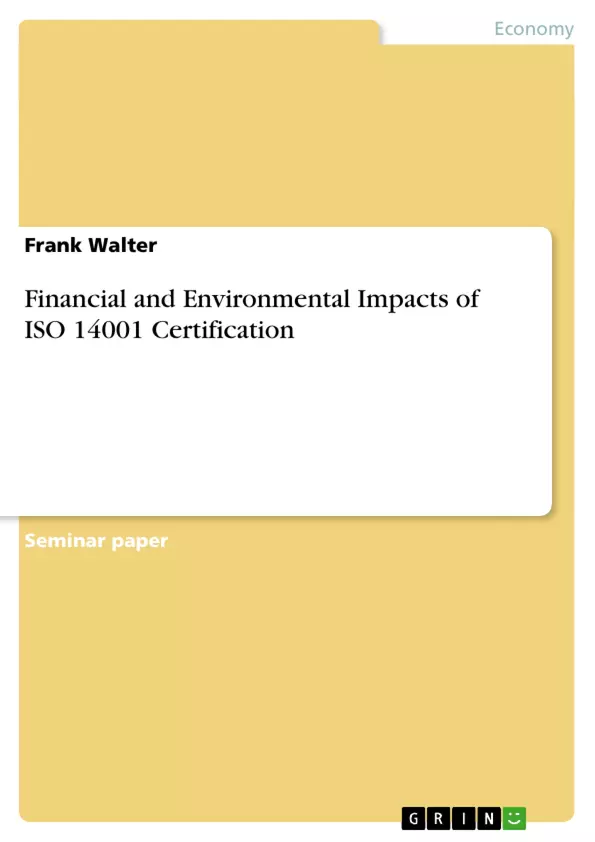Interest in environmental management has been growing strongly in the corporate world over the recent years. It has been boosted by theorists and practitioners who promised huge win- win opportunities in this area, with ecologically conscious management practices benefiting the natural environment and at the same time advancing the competitiveness of companies or even national economies (e.g., PORTER 1991). Even though this win-win rhetoric has been criticized sharply (e.g., WALLEY/WHITEHEAD 1994), environmental management remained an important part of many businesses’ agenda for different motives - be it in order to exploit win-win potentials or to ensure legal compliance (AN- DREWS etal. 2001), or be it intrinsically motivated, in order to avoid doing harm to the natural environment.
One way of implementing and maintaining environmental management is by institutionalizing an environmental management system (EMS). Such an EMS constitutes a structured and systematic approach for “articulating goals, making choices, gathering information, measuring progress, and improving performance” in the environmental field (FLOR- IDA/DAVISON 2001:64). There is a wide array of different types of EMS’s, reaching from company specific solutions to standardized national (like the British BS 7750), multinational (like the European Union’s EMAS), or even global approaches (like the International Organization for Standardization’s ISO 14001) (KRUT/GLECKMAN 1998). The ISO 14001 standard achieved particular prominence as an EMS: In July 2003, more than 53,000 organizations all over the world had an EMS which was certified according to ISO 14001 guide lines (PEGLAU 2003; see also chapter 2.2 of this paper). Its proponents promise huge environmental and financial/operational benefits. They assume that by implementing an ISO 14001 certified EMS, a company can improve both its natural environment and its bottom- line.
Inhaltsverzeichnis (Table of Contents)
- Introduction
- Environmental Management Systems and ISO 14001
- Introducing Environmental Management Systems and ISO 14001
- Global Dissemination of ISO 14001
- Potential Impacts of ISO 14001
- Review of the Empirical Literature on ISO 14001's Impacts
- Financial Impacts
- Qualitative Studies
- Quantitative Studies
- Environmental Impacts
- Qualitative Studies
- Quantitative Studies
- Financial Impacts
- Assessment of the Empirical Literature on ISO 14001's Impacts
- Criticism of Existing Empirical Literature
- Suggestions for Further Research
- Conclusion
Zielsetzung und Themenschwerpunkte (Objectives and Key Themes)
This paper presents a comprehensive overview of the current research on the financial and environmental impacts of ISO 14001 certification. It examines existing empirical and conceptual literature, evaluating its methodological approaches and proposing directions for future research.
- The role of ISO 14001 in promoting environmental management and sustainability within organizations.
- The potential financial benefits and challenges associated with ISO 14001 certification.
- The effectiveness of ISO 14001 in achieving environmental improvements.
- The critical analysis of existing research on ISO 14001's impacts.
- Recommendations for future research to address the limitations of current studies.
Zusammenfassung der Kapitel (Chapter Summaries)
- Introduction: This chapter sets the stage by discussing the growing interest in environmental management in the corporate world, highlighting the win-win rhetoric surrounding environmental practices and the emergence of Environmental Management Systems (EMSs) as a structured approach to managing environmental impacts. It introduces ISO 14001 as a prominent EMS standard and highlights the need for empirical research to assess its actual impacts.
- Environmental Management Systems and ISO 14001: This chapter defines EMSs and provides a detailed overview of ISO 14001, including its key elements, such as environmental policy, planning, implementation, monitoring, and management review. It also explores the potential benefits of ISO 14001 certification as argued by proponents and critics.
- Review of the Empirical Literature on ISO 14001's Impacts: This chapter delves into the empirical research on the financial and environmental impacts of ISO 14001, examining both qualitative and quantitative studies. It analyzes the findings from various research projects, highlighting the different perspectives and methodologies employed.
- Assessment of the Empirical Literature on ISO 14001's Impacts: This chapter critically evaluates the existing literature, identifying methodological limitations and suggesting directions for future research to address these shortcomings. It aims to improve the quality and rigor of future studies on ISO 14001's impacts.
Schlüsselwörter (Keywords)
The main keywords and focus topics of this paper include: environmental management, ISO 14001, environmental management systems (EMS), sustainability, financial impacts, environmental impacts, empirical research, methodology, critical analysis, future research.
- Quote paper
- Frank Walter (Author), 2004, Financial and Environmental Impacts of ISO 14001 Certification, Munich, GRIN Verlag, https://www.grin.com/document/24603



